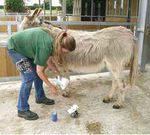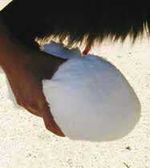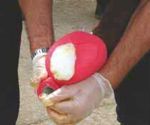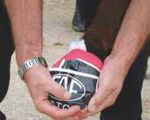Difference between revisions of "Laminitis - Donkey"
| (22 intermediate revisions by the same user not shown) | |||
| Line 1: | Line 1: | ||
| − | + | ==Introduction== | |
| − | + | [[Image:Apply cotton wool pad donkey.jpg|right|thumb|150px|<small><center>Apply cotton wool pad (Image courtesy of [http://drupal.thedonkeysanctuary.org.uk The Donkey Sanctuary])</center></small>]] | |
| − | + | [[Image:Cotton wool pad donkey.jpg|right|thumb|150px|<small><center>Cotton wool pad in place(Image courtesy of [http://drupal.thedonkeysanctuary.org.uk The Donkey Sanctuary])</center></small>]] | |
| − | + | [[Image:Secure with bandage donkey.jpg|right|thumb|150px|<small><center>Secure with bandage (Image courtesy of [http://drupal.thedonkeysanctuary.org.uk The Donkey Sanctuary])</center></small>]] | |
| − | + | [[Image:Adhesive patches donkey.jpg|right|thumb|150px|<small><center>Finally add adhesive, waterproof patches (Image courtesy of [http://drupal.thedonkeysanctuary.org.uk The Donkey Sanctuary])</center></small>]] | |
| − | + | This is a common, yet often unrecognised problem, and often is not noticed by the donkey owner, especially mild, acute, frequently recurring episodes. Donkeys, like ponies, are susceptible. All four feet can be affected, but it is more common in the front feet. Obesity and a high carbohydrate diet are the most common risk factors, obese animals being at the highest risk. Other causes include trauma to the foot, weight-bearing if the other limb is injured, long or badly trimmed feet, [[Hyperlipaemia - Donkey|hyperlipaemia]], toxaemia and [[Colic - Donkey|colic]]. | |
| − | |||
| − | |||
| − | |||
| − | |||
| − | |||
| − | |||
| − | This is a common, yet often unrecognised problem, and often is not noticed by the donkey owner, especially mild, acute, frequently recurring episodes. | ||
Predisposing factors: | Predisposing factors: | ||
| Line 20: | Line 13: | ||
* Systemic illness (eg. Pituitary pars intermedia disorder, toxaemia) | * Systemic illness (eg. Pituitary pars intermedia disorder, toxaemia) | ||
| − | == | + | ==Clinical Signs== |
| − | + | ||
| − | + | Laminitis is a painful condition. | |
| + | |||
| + | * Lameness, laminitic stance | ||
* Reluctance to move, preference for soft surfaces, recumbency | * Reluctance to move, preference for soft surfaces, recumbency | ||
* Foot pain, particularly middle coronary band area | * Foot pain, particularly middle coronary band area | ||
* Pulse pressure and volume is increased in the digital arteries | * Pulse pressure and volume is increased in the digital arteries | ||
| − | * Shifting weight, frequent lifting of the front feet | + | * Shifting weight, frequent lifting of the front feet above the ground, a stance not exhibited by horses. |
* Weight-bearing on the heels | * Weight-bearing on the heels | ||
* Feet landing heel first | * Feet landing heel first | ||
* Increased pulse and respiratory rate due to pain | * Increased pulse and respiratory rate due to pain | ||
| + | * Sweating | ||
Laminitis should be treated as an emergency. Any combination of feet may be affected and all should be assessed. Full clinical examination should be performed. | Laminitis should be treated as an emergency. Any combination of feet may be affected and all should be assessed. Full clinical examination should be performed. | ||
| − | |||
| − | |||
| − | |||
| − | |||
==Treatment== | ==Treatment== | ||
* Remove inciting cause and treat precipitating condition | * Remove inciting cause and treat precipitating condition | ||
* Analgesia - i.v. first, continue by mouth e.g. [[NSAIDs#Phenylbutazone|phenylbutazone]] | * Analgesia - i.v. first, continue by mouth e.g. [[NSAIDs#Phenylbutazone|phenylbutazone]] | ||
| + | * [[Phenothiazines#Acepromazine|Acetylpromazine]] - '''monitor for excessive sedation''' | ||
| + | * Footpads - entire sole covered with thick soft dressing ('''N.B. frog supports are most likely inappropriate for donkeys''') | ||
| + | * Deep shavings bed advantageous | ||
| + | * Minimise walking, rest - many weeks are necessary to regain lamellary stability | ||
| + | * Appropriate diet | ||
| + | ** Limited meadow hay | ||
| + | ** Feed straw | ||
| + | ** High fibre, low carbohydrate feeds | ||
| + | ** '''Do not starve''' | ||
| + | * Re-examine after 24 hours if possible | ||
| + | * Owner education | ||
| + | ** [[Laminitis - Donkey#Nursing Care|Nursing duties]] | ||
| + | ** Feeding | ||
| + | ** Farriery | ||
| + | * Unresponsive cases should be radiographed | ||
| + | * Recurrent cases - consider blood sampling and urine testing | ||
| + | * Weight control strategy if appropriate | ||
| + | * Potential requirement of more frequent farriery if hoof growth accelerates after laminitis | ||
| + | |||
| + | ==[[Nursing Care - Donkey|Nursing Care]]== | ||
| + | |||
| + | Due to a donkey’s stoical nature, mild cases of laminitis can go unnoticed, particularly if the animal receives no exercise. It is important to '''check the digital pulses of hospitalised donkeys''' so that early treatment can be instigated. | ||
| + | |||
| + | Provide box-rest on a deep, inedible bed of paper or shavings so that the diet can be controlled. Ensure that water and food are within easy reach as it can be too painful for some animals to make the effort to move. | ||
| + | |||
| + | '''Foot pads''' provide some relief to the donkey. Pick out the feet and pad with a thick layer of cotton wool, bandage in place with a cohesive bandage. Adhesive patches designed for big bale silage (''e.g.'' JAF-Patch, available from agricultural suppliers) can be applied to the bandage to make the dressings more waterproof. '''Sugardine paste''', which is made from granulated sugar mixed with povidone-iodine antiseptic solution, can be applied to the sole beneath the cotton wool. This helps keep the foot clean, hardens soft soles and helps control infection. | ||
| + | |||
| + | Change foot dressings daily and check the '''sole for bruising and infection'''. If the donkey spends long periods lying down, check for '''pressure sores''', particularly on elbows and stifles. | ||
| + | |||
| + | ==Literature Search== | ||
| + | [[File:CABI logo.jpg|left|90px]] | ||
| + | |||
| + | |||
| + | Use these links to find recent scientific publications via CAB Abstracts (log in required unless accessing from a subscribing organisation). | ||
| + | <br><br><br> | ||
| + | [http://www.cabdirect.org/search.html?q=ab%3A%28laminitis%29+AND+od%3A%28donkeys%29 Laminitis in donkeys related publications] | ||
| − | |||
==References== | ==References== | ||
| − | * '''The Professional Handbook of the Donkey''', | + | |
| + | * Crane, M. (2008) The donkey's foot In Svendsen, E.D., Duncan, J. and Hadrill, D. (2008) ''The Professional Handbook of the Donkey'', 4th edition, Whittet Books, Chapter 10 | ||
| + | * Dabinett, S. (2008) Nursing care In Svendsen, E.D., Duncan, J. and Hadrill, D. (2008) ''The Professional Handbook of the Donkey'', 4th edition, Whittet Books, Chapter 18 | ||
| + | |||
| + | |||
| + | {{toplink | ||
| + | |backcolour = D1EEEE | ||
| + | |linkpage =Foot Conditions - Donkey | ||
| + | |linktext =Foot Conditions - Donkey | ||
| + | |pagetype=Donkey | ||
| + | }} | ||
| + | {{infotable | ||
| + | |Maintitle = [[Sponsors#The Donkey Sanctuary|This section was sponsored and content provided by '''THE DONKEY SANCTUARY''']] | ||
| + | |Maintitlebackcolour = B4CDCD | ||
| + | }} | ||
| + | [[Category:Donkey]] | ||
| + | [[Category:Foot_Conditions_-_Donkey]] | ||
| + | [[Category:Nursing_Care_-_Donkey]] | ||
Latest revision as of 22:02, 18 October 2010
Introduction




This is a common, yet often unrecognised problem, and often is not noticed by the donkey owner, especially mild, acute, frequently recurring episodes. Donkeys, like ponies, are susceptible. All four feet can be affected, but it is more common in the front feet. Obesity and a high carbohydrate diet are the most common risk factors, obese animals being at the highest risk. Other causes include trauma to the foot, weight-bearing if the other limb is injured, long or badly trimmed feet, hyperlipaemia, toxaemia and colic.
Predisposing factors:
- Pastures rich in soluble carbohydrate/fructans
- Overweight donkey
- Excessive feed amount, especially cereal type mixtures
- Trauma (poor/not appropriate farriery, overgrown hooves, lameness in contralateral limb)
- Systemic illness (eg. Pituitary pars intermedia disorder, toxaemia)
Clinical Signs
Laminitis is a painful condition.
- Lameness, laminitic stance
- Reluctance to move, preference for soft surfaces, recumbency
- Foot pain, particularly middle coronary band area
- Pulse pressure and volume is increased in the digital arteries
- Shifting weight, frequent lifting of the front feet above the ground, a stance not exhibited by horses.
- Weight-bearing on the heels
- Feet landing heel first
- Increased pulse and respiratory rate due to pain
- Sweating
Laminitis should be treated as an emergency. Any combination of feet may be affected and all should be assessed. Full clinical examination should be performed.
Treatment
- Remove inciting cause and treat precipitating condition
- Analgesia - i.v. first, continue by mouth e.g. phenylbutazone
- Acetylpromazine - monitor for excessive sedation
- Footpads - entire sole covered with thick soft dressing (N.B. frog supports are most likely inappropriate for donkeys)
- Deep shavings bed advantageous
- Minimise walking, rest - many weeks are necessary to regain lamellary stability
- Appropriate diet
- Limited meadow hay
- Feed straw
- High fibre, low carbohydrate feeds
- Do not starve
- Re-examine after 24 hours if possible
- Owner education
- Nursing duties
- Feeding
- Farriery
- Unresponsive cases should be radiographed
- Recurrent cases - consider blood sampling and urine testing
- Weight control strategy if appropriate
- Potential requirement of more frequent farriery if hoof growth accelerates after laminitis
Nursing Care
Due to a donkey’s stoical nature, mild cases of laminitis can go unnoticed, particularly if the animal receives no exercise. It is important to check the digital pulses of hospitalised donkeys so that early treatment can be instigated.
Provide box-rest on a deep, inedible bed of paper or shavings so that the diet can be controlled. Ensure that water and food are within easy reach as it can be too painful for some animals to make the effort to move.
Foot pads provide some relief to the donkey. Pick out the feet and pad with a thick layer of cotton wool, bandage in place with a cohesive bandage. Adhesive patches designed for big bale silage (e.g. JAF-Patch, available from agricultural suppliers) can be applied to the bandage to make the dressings more waterproof. Sugardine paste, which is made from granulated sugar mixed with povidone-iodine antiseptic solution, can be applied to the sole beneath the cotton wool. This helps keep the foot clean, hardens soft soles and helps control infection.
Change foot dressings daily and check the sole for bruising and infection. If the donkey spends long periods lying down, check for pressure sores, particularly on elbows and stifles.
Literature Search
Use these links to find recent scientific publications via CAB Abstracts (log in required unless accessing from a subscribing organisation).
Laminitis in donkeys related publications
References
- Crane, M. (2008) The donkey's foot In Svendsen, E.D., Duncan, J. and Hadrill, D. (2008) The Professional Handbook of the Donkey, 4th edition, Whittet Books, Chapter 10
- Dabinett, S. (2008) Nursing care In Svendsen, E.D., Duncan, J. and Hadrill, D. (2008) The Professional Handbook of the Donkey, 4th edition, Whittet Books, Chapter 18
|
|
This section was sponsored and content provided by THE DONKEY SANCTUARY |
|---|
